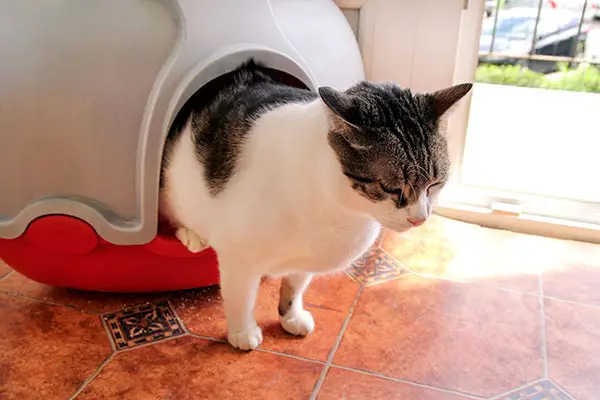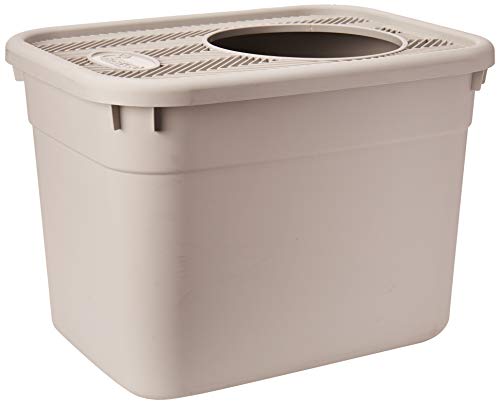Cats not only hold the record for the most curious pets. They can be highly unpredictable too.
It’s not unusual to come home one day to the worrying discovery that your litter-trained kitty is suddenly peeing over the edge of the litter box and not inside the box. It’s even worse if the animal is peeing all over the place.
As a concerned pet parent, not only can this behavior be infuriating. It can also be puzzling. That’s when you may find yourself wondering, why does my cat keep peeing over the edge of the litter box?
Numerous reasons could cause your cat to pee over the edge of the litter box and not inside of it. The reasons can range from factors as trivial as a dislike for the litter box to more severe issues like urinary tract infection. The onus is on you as the cat’s owner to get to the bottom of the issue.
However, the most important thing to note here is that a properly litter-trained cat will unlikely pee outside his litter box without apparent reasons. And in many cases, this behavior will necessitate a visit to the vet.
If you’re a loving pet parent who’s always wondering the reasons for your cat peeing over edge of litter tray, you’re in luck. This post highlights all the possible reasons your adorable feline friend could be peeing outside his litter box. You’ll also learn of what you can do to stop or redirect this aberrant behavior.
Table of Contents
Reasons for a Cat Peeing Over Edge of Litter Box
One frequently-reported litter-related concern by most cat owners is, ‘my cat keeps peeing over edge of litter box, what could be the reasons behind this habit and should I be worried?’
We’ll begin by answering the last bit of the question by saying that yes, you should be worried if you discover that your cat suddenly pees over the edge of his litter box and not inside the box. But first, it’s important to uncover the real reasons behind this puzzling behavior.
The following are all the possible reasons your cat could be peeing outside of his litter box;
1. Poor Training
Inadequate litter training is one of the most likely reasons your cat is peeing outside his litter box.
Cats might be more intelligent than most household pets. But they’re not as smart as humans to know where they should empty their bladder. At least not without some prior training.
2. Problems With the Litter Box
Cats have quirky preferences. A seemingly insignificant issue with your cat’s litter box might cause the cat to avoid the box altogether.
When that happens, your kitto could choose to pee over the box’s edge as opposed to inside of it. Worse yet, the animal could pee all over the place, including on your couch or bed.
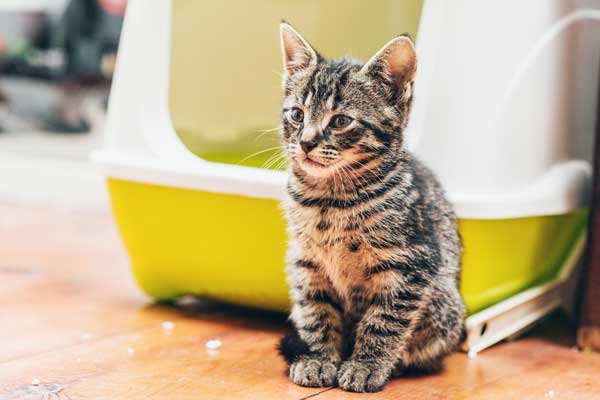
Below are a few potential issues with a cat’s litter box that could cause the animal to pee over the edge of the box;
a. Litter Box Size
A small litter box is the most common reason a cat may dislike his litter box and choose to pee over its edge.
If the size of your cat isn’t proportional to that of his litter box, then it becomes difficult for the animal to aim inside of the box accurately.
Therefore, the pee will be all over the edge of the box.
b. Litter Box Shape
Do cats have shape preferences? Surprising as it may sound, they actually do. That’s why you’ll find that most cat toys resemble a mouse or bone.
The reason cats are remarkably able to recognize shapes is that they have many rod cells. These cells are more sensitive to light than cone cells, making it easier for cats to recognize shapes and movements in poorly-lit conditions.
Obviously, you wouldn’t want to get your kitto a litter box that resembles a mouse or bone as the animal would end up playing with the box and not utilizing it for the intended purpose. Instead, you might want to go for a circular litter box.
Anecdotal reports by millions of pet owners indicate cats are more drawn to circular and oval shapes than square or rectangular ones.
c. Litter Box Color
Initially, most people believed that cats see the world in black and white. But numerous scientific studies have since debunked this misconception.
Cats are able to detect blue hues with ease. These animals are more specifically designed to perceive blue-violet hues, with some also able to see yellow-green light wavelengths.
However, cats are not able to see red-orange hues. It’s important to bear these color considerations in mind while sourcing for your cat’s litter box.
d. Dirty Litter Box
Cats are undeniably the cleanest household pets. They may spend up to two-thirds of their time sleeping. But the majority of their waking hours goes to grooming.
So, if you keep your cat’s litter box dirty, the animal will avoid peeing inside the box and instead pee over its edge. Worse yet, your cat may avoid a dirty litter box altogether and choose a completely different place to complete his business.
Maybe you’ve always wondered, ‘my cat stands on edge of litter box to pee or poop, why is this so?’
As we’ve just examined, cats are repulsed by a dirty litter box. If you realize that your cat stands on edge of litter box to poop or pee, then it’s about time you cleaned the box.
e. Litter Box Smell
A dirty litter box will also exude an unpleasant smell. That’s especially true for a litter box soiled in cat pee or poo.
But besides the smell of pee or poo, several other smells may repulse your cat.
These can range from the smells of common household detergents and shampoos to that of spices like onion, garlic, and peppermint.
f. Litter Box Location
Cats are habitual creatures who detest routine changes. Your cat will be more comfortable peeing in the same location most of the time.
However, it could happen that your cat doesn’t like the location of his litter box. This is usually a problem with litter boxes placed in high foot traffic areas, such as in the doorway.
A cat may also avoid a litter box placed in plain sight. Not only do these adorable furballs have a high sense of hygiene. They’re also secretive and prefer to go when no one else is watching them.
Peeing over the edge of his litter box is the cat’s way of saying, ‘hey, you’ve got to move this thingy to a different location.’
g. Litter Box Accessibility
Physical location is only one of the many aspects that determine a litter box’s accessibility. Another factor relates to whether the box is covered or not.
Your cat’s litter box might be placed in the right spot, alright. But if the box is covered, your feline friend may not be smart enough to lift the lid before using it.
The cat’s natural instincts would be to pee over the edge of the box.

3. Territoriality
Cats are highly territorial animals. One way they lay claim to their territory is by spraying urine on surrounding objects. That includes their litter box.
If you occasionally discover small amounts of urine over the edge of your cat’s litter box, it could mean your cat is trying to mark his territory. This is especially a problem for households with many cats where conflicts over toys and mates are rampant.
4. Old Age Problem
Like all animals, the muscles in a cat’s body become less flexible with age. This loss of muscle flexibility mostly affects an animal’s bladder and, with time, his bowels too.
Therefore, the most plausible explanation for your elderly cat peeing over the edge of litter box is that the cat is losing his bladder continence. With reduced bladder control, the cat finds it difficult to direct his pee at the center of the litter box.
Feline arthritis is another age-old issue that could make your cat to pee over the edge of his litter box and not inside of it. Arthritis manifests in extreme joint pain and bone inflammation. As the cat’s muscles are excruciatingly painful, the animal will avoid making contact with the litter box to pee. Instead, he chooses to go on the edge of the box where he wouldn’t suffer any pain.
5. Underlying Medical Conditions
We’ve already pointed out anxiety as one of the primary medical issues causing elderly cats to pee or poo over the edge of their litter box.
But there’s a whole lot of ailments that could make your cat develop aberrant litter habits. Most of these are conditions that affect a cat’s kidneys, resulting in reduced bladder control.
Examples include;
- Urinary Tract Infection (UTI)
- Cystitis
- Bladder stones
- Chronic renal (kidney) failure (CRF)
- Hyperthyroidism (hyperactive thyroid gland)
- Diabetes
Besides renal issues, certain mental conditions could also affect your cat’s potty habits. One such disorder is separation anxiety, an anxiety disorder common in household pets that are abandoned for long without sufficient provisions for stimulation.
6. Injury
Not many cat owners will attribute the habit of peeing over the litter box to a paw injury. However, a sore paw is a major reason cats avoid their litter, toys, and basically everything else.
Instead of going inside the box, a cat with an injured paw will find more comfort using the edge of the tray. It’s the animal’s way of minimizing contact with the box and avoiding further injury to the sore paw.
And that pretty much answers the question ‘why does my cat stand on edge of litter box to poop?’
- NAMED BEST CAT LITTER BOX UPGRADE: The New York Times Wirecutter named the Modkat Flip Litter Box the best cat litter box upgrade....
- 3-POSITION LID: The innovative 3-position flipping lid is a unique feature that sets Flip apart from traditional litter boxes. The...
- STOPS LEAKS AND SCATTER: The full-height, seamless base effectively prevents leaks and litter scatter. It is perfect for cats who...
Last update on 2024-07-26 / Affiliate links / Images from Amazon Product Advertising API
Does Peeing Over the Edge of a Litter Box More of a Male Than Female Cat Problem?
Both male and female cats generally pee outside their litter box for the same reasons. However, certain factors could make this habit more common for male than female cats, and vice versa.
For instance, your male cat peeing over edge of litter box is likely due to territoriality. While all cats are territorial by nature, male cats are a lot more defensive of their space than their female counterparts.
It’s also worth noting that tomcats tend to be more territorial in households or neighborhoods with other domineering male cats.
Is it normal to catch a female cat peeing over edge of litter box?
Absolutely. A female cat can pee over the edge of his litter box for the same reasons as any other cat. In fact, female cats can also be occasionally territorial and spray their urine to cordon off their space. One of the occasions your female cat could become fiercely territorial is when she’s nursing.
Should I Punish My Cat For Peeing Outside The Litter Box?
Some pet parents may be tempted to punish their cats by hitting or yelling at the animal if they pee outside the litter box. Others may rub the cat’s nose on his pee or poo as a way of punishing him.
However, it’s not okay to hit, scold, or otherwise punish your cat for inappropriate litter habits (or for any reason for that matter). Punishing your cat may only reinforce the undesired behavior. Besides, the animal may turn aggressive and fight back, inflicting serious wounds on your face.
Remember that cats don’t go outside their litter box out of spite. There’s usually a valid reason and it’s upon you to dig deeper and uncover the cause behind this behavior.
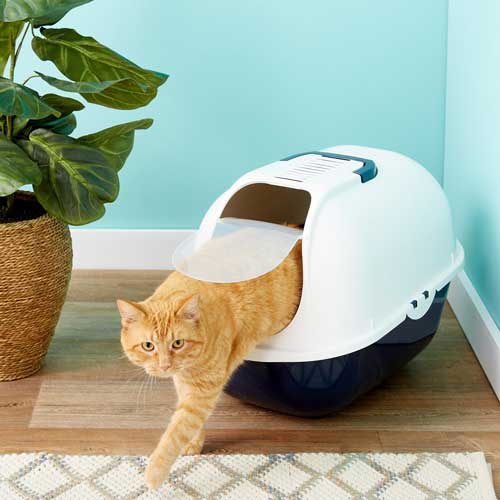
How Do I Stop My Cat Peeing Over the Edge of the Litter Box?
Once in a while, cats develop unpleasant litter habits like peeing outside the litter box. As a responsible pet parent dealing with such a cat, you’ll find yourself wondering – my cat pees over the edge of the litter box, is there anything I can do to make him stop?
As we’ve already explained, there are numerous reasons your cat could be going outside his litter box. The onus is on you to understand what to do if your cat is peeing over the edge of the litter box and not in it.
Fortunately, there are several tips you can implement to help your adorable furball out of the behavior. First off, you’ll need to settle a couple of questions as a way of getting to the bottom of the matter. For instance;
- When did your cat start peeing over the edge of his litter box?
- How long has this habit persisted?
- When is the problem more intense?
- Is it more of a male or female cat problem?
- What are other unusual physical or behavioral symptoms with the affected cat?
How you answer these questions will determine the right methodology to adopt. Remember, the solution depends on the underlying triggers.
Below are the various potential solutions to the problem of a cat peeing over his litter box, depending on the cause of the problem;
1. Litter-train Your Cat
There are no two ways about this. If you suspect that your cat’s unpleasant litter habits are due to poor or inadequate training, then the best way out of the problem is to litter-train the animal.
Most cats can be litter-trained as soon as they’re three weeks old. The earlier the better.
You can even litter-train kittens younger than three weeks. All you need to do is stimulate the cat using incentives like a treat.
Also, remember to investigate a cat’s history thoroughly before adopting him. Focus on the animal’s medical profile and behavioral traits.
That’s especially true for cats adopted from rescue shelters.
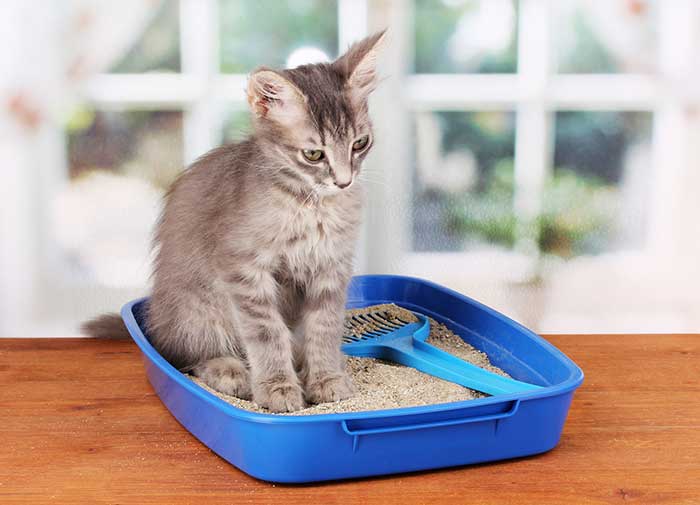
2. Fix Issues With Your Cat’s Litter Box
We did highlight several litter box issues that could make a cat pee over the box and not inside of it. As you might expect, the right solution depends on the specific litter box problem in question.
a. Small Litter Box
A cat’s litter box should be proportionate to the animal’s size. Avoid disproportionately small boxes as these will only encourage the cat to go outside the box.
Avoid very deep boxes too. Some cats are scared of sheer depth.
b. Litter Box Shape
Since cats are more drawn to circular shapes, it makes sense to get them an equally circular litter box.
Oval boxes might also work wonders.
c. Litter Box Color
Cats prefer blue and violet colors. So, their litter box should preferably be of these colors.
A bit of green and yellow would work too.
d. Dirty Litter Box
You don’t need a sanitation expert or veterinary officer to remind you about the health implications of leaving your cat’s litter box dirty.
Depending on what’s in the box, a dirty litter box could offer a passageway for bacterial infections.
The best practice when cleaning a cat’s litter box is to clean the box right after use. You might also consider giving it one final wash at the end of each day.
e. Smelly Litter Box
Cleaning your cat’s litter box often enough will go a long way in eliminating unpleasant odors.
However, it’s important to avoid cleaning the litter box with regular household shampoos or detergents. Use plain water and non-fragranced soaps instead.
Also, minimize contact with human perfumes. The smell caused by these products might stress your cat out.
f. Inaccessible Litter Box
Your cat’s litter box should be placed in a fairly accessible location. Set the box in a spot with low foot traffic, but one where the cat frequents a lot.
However, the location shouldn’t be around where the cat eats or drinks. Also, ensure the box is uncovered at all times.
Sometimes, you might find that the best solution is to replace your cat’s litter box altogether. The good news is that there are plenty of options to consider.
- Clever top entry design that cats love
- Eliminates tracking and is virtually dog-proof
- Reduces litterbox odor
Last update on 2024-07-26 / Affiliate links / Images from Amazon Product Advertising API
Below are common product recommendations when looking for an excellent litter box for your kitty;
i. Clevercat Top Entry Litterbox
Clevercat Top Entry Litterbox measures 20 x 15 x 15 inches and weighs 4 pounds, making it remarkably portable. However, the box is large enough to be used by both cats and dogs.
A clever top-entry design prevents over-the-edge spills.
ii. Catit Jumbo Hooded Cat Litter Pan
Catit Jumbo Hooded Cat Litter Pan is another lightweight cat litter box you might consider. The box measures 21.26 x 16.93 x 18.11 and weighs a paltry 760 grams.
It features a large hood that lifts up to allow ease of access while cleaning or emptying the box. The inclusion of a carbon-impregnated filter helps trap and eliminate bad litter box odors.
iii. Petphabet Jumbo Hooded Cat Litter Box
Petphabet Jumbo Hooded Cat Litter Box is a perfect option for cat owners looking for a relatively large litter box. Measuring 25 x 19 x 17 inches and weighing 3.12 pounds, this litter box is large enough to serve two average-sized cats simultaneously.
The product comes with a removable clear top cover that lets you see what’s inside. It also includes a high back and lid that prevents pee spillovers.
iv. IRIS USA Top Entry Cat Litter Box with Cat Litter Scoop
If variety and size are your primary considerations in a cat litter box, then you should definitely consider the IRIS USA Top Entry Cat Litter Box with Cat Litter Scoop. The box measures 20.75 x 16.13 x 14.63 inches, weighs 4.6 pounds, and comes in various color options.
IRIS USA sports a grooved lid that helps remove litter particles from a cat’s paws, making it the best litter box for messy cats. An included litter scoop makes cleaning a breeze.
- MADE IN USA with global materials - The IRIS USA top entry kitty litter tray offers a functional and aesthetically pleasing...
- TOP ENTRY - The top entry of the cat litter pan means more privacy for your cat, less litter spillage, and any spraying remains...
- TIDY - The grooves in the lid catch any lingering litter particles on your cat's paws and keep them from spilling out onto the...
Last update on 2024-07-26 / Affiliate links / Images from Amazon Product Advertising API
As you endeavor to get your cat the right litter box, it’s also important to purchase suitable litter. Cat litter refers to the material, usually adsorbent and in granular form, used to line the bottom of a cat’s litter box. Most cat litter is made of clay. The product may also include other natural ingredients like wheat, corn, baking soda, mineral oil, and cat-friendly fragrances.
SmartCat All Natural Clumping Litter is a perfect recommendation for cat litter. The product weighs 20.1 pounds and is made of grass seed. This cat litter is unscented, making it excellent for most cats. It’s also free from GMOs, dust particles, and toxic chemical additives.
ÖKOCAT Natural Wood Clumping Litter is another great litter that you might consider getting for your adorable kitty. Weighing in at 11.2 pounds, ÖKOCAT Natural is made of wood fiber designed to naturally prevent enzymes from bonding with liquid and cat waste, helping to the creation of ammonia and foul odor. The product is non-fragranced and contains no synthetic chemicals, GMOs, or toxic dyes. It’s also more than 99% dust-free.
3. Fix Spraying Issues
Most cats will spray urine on their litter boxes as a way of scent-marking their territories. This is a common issue where there’s more than one cat in the household.
You can fix this problem by buying extra litter boxes for the frightful, less dominant cat. Place the litter boxes at different places or in different rooms so that the cat can have multiple options on where to pee.
4. Keep Your Cat Stimulated
Cats require constant physical and mental stimulation during their waking hours. An understimulated cat may develop separation anxiety or simply resort to bad litter habits like peeing over the edge of the litter box.
The best way to fix this issue is by ensuring your cat gets enough physical and mental stimulation. That includes playing and exercising with the cat, as well as showering him with plenty of interactive toys.
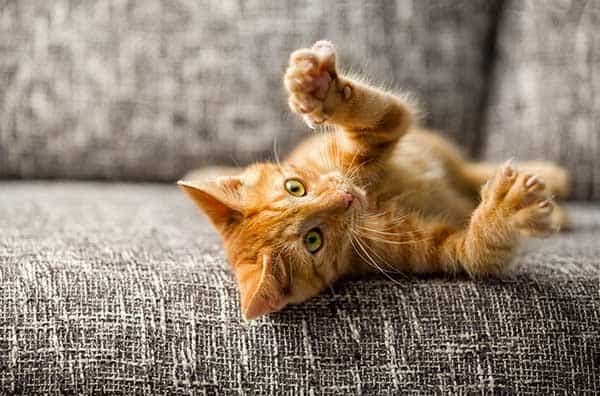
5. Take the Cat for Professional Checkup
If all the above interventions fail despite your best effort, then it’s time to take your cat to the vet.
The vet will conduct a series of tests to determine if the cat is suffering from an injury or underlying disease causing him to peeing outside the litter box.
Conclusion
Various reasons could make a cat go outside the litter box and not inside the box.
Fortunately, there are several ways to stop or redirect this behavior. The solutions to implement depend on the underlying cause of the problem.
Checkout Our Favorite Cat Products
1. Best Online Course For Cat Parents
Our favorite: The Cat Language Bible (How to Finally Understand And Speak to Your Cat) – A new form of cat to human communication that many cat owners have dreamed about… but few have actually thought possible.
2. Best Immune Support For Cats
Our favorite: Tomlyn Immune Support – Best Supplement for Cats and Kittens.
3. Best Cat Treats
Our favorites: LIFE ESSENTIALS All Natural Freeze Dried Chicken And Sheba Meaty Tender Sticks – Both are Great.

